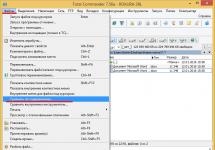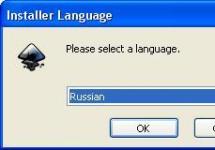One day I was about to upload a 4 GB folder onto my 16 GB flash drive, and I saw an amazing message that there was not enough space on the media, although there were no other files there. I looked at the properties and saw that the flash drive had decreased in size and was now about 120 MB. I thought formatting would solve the problem, so I tried. However, even after formatting, the previous size of the flash drive did not return. If you have the same problem, then this article will help you.
As a rule, reducing the size of a flash drive is a virtual malfunction, which manifests itself in the fact that the storage device is divided into two areas, one of which is marked (the one that is visible to us), and the second is unmarked (we do not see it in the explorer and nothing we can do with it). Repairing a flash drive in this case consists of combining and marking these areas properly.
Making a diagnosis
Before you begin, make sure that your flash drive has decreased in size precisely because it was incorrectly divided into parts. To make a diagnosis, do the following:
- Connect the flash drive to your computer.
- In the window that opens, enter diskmgmt.msc and click "OK".
- The Disk Management window will appear, in which you need to find your removable disk.
You should see a picture similar to the one shown in the screenshot - part of the disk with the status “Good”, and the other “Not allocated”.
 Diagnosing the problem
Diagnosing the problem If this is the case for you, then congratulations - now we will fix everything!
How to fix a flash drive
If the flash drive has decreased in size due to improper partitioning, then to fix the problem, you will need to follow the steps described below. There won't be anything complicated. The flash drive must be connected to the computer.
- Press the combination “Win+R” on your keyboard.
- In the window that opens, enter cmd.exe and click the button"OK".
- In the command line that appears, enter diskpart and press the Enter key. This command launches a disk utility that has more capabilities than the one described above.
- Now enter listdisk and press "Enter". You will see a list of media. You need to find in this list the disk that is your flash drive. You can only navigate by the volume of the device (the real volume of the flash drive will be shown here, and not the one that has decreased).
- When the flash drive is found in the list, write selectdisk=N and press "Enter". "N" is the disk number in the list.
- When the drive is selected write clean and press "Enter". A message appears indicating that the disk was erased successfully.
 Cleaning the flash drive
Cleaning the flash drive - The flash drive is clean. Now you need to mark it as it should. To do this, go to “Disk Management” again (Combination “Win + R”, command diskmgmt.msc and “Ok.”)
- Find your flash drive in the list, right-click on it and select “Create simple volume”.
- The “Create Simple Volume Wizard” will open. Complete its work, and your flash drive will return to its previous size.
 Recovering a flash drive
Recovering a flash drive And that is all. If the flash drive has decreased in size, then the described method will most likely solve the problem.
Many people who work with flash memory cards (flash drives), such as photographers, sometimes encounter a problem - the flash drive has decreased in volume. Moreover, this can happen unexpectedly - imagine the situation - you insert a USB drive and instead of the expected 4Gb of memory you see that you have only 56 Mb on the flash drive.
As strange as it was, this problem can be solved using standard Windows tools. It is worth immediately taking into account that situations are different. This method is not 100% accurate. But he can really help. Let's take this situation as an example. A 16 GB flash drive has lost 50% of its memory. After which only 8 GB became available on it!
As mentioned earlier, there is a solution and it’s quite simple. Almost anyone who finds themselves in a similar situation will be able to restore the full capacity of their flash drive in just a minute.
So, let's begin. First, let's open the disk manager. For this:
- Open Control Panel (Start\Control Panel).
- Open Administration.
- If you have Windows 7, 8, 10, then enter the phrase “administration” in the search bar (top right), and the corresponding item will appear in the control panel.
- If you have Windows Vista, switch the Control Panel to "Classic View" in the menu on the left if you haven't already done so.
- Open Computer Management. (also, steps 1 to 3 can be completed even faster - to do this, you just need to right-click on the “My Computer” shortcut on the desktop and select the “Manage” menu item).
- Click on “Disk Management” in the tree on the left.

So, we see that the flash drive (in our case it is EOS_DIGITAL J:) is divided in a very strange way. Half is occupied by the active partition, and half of the flash drive is simply not partitioned. We click on the active partition and see a sad picture - we can neither delete this partition nor expand it to the entire volume of the flash drive.

We click on the unmarked area with the right mouse button and see an even sadder picture - we cannot do anything with the unmarked area. (to put it simply, if you imagine a flash drive as a bottle with two compartments, then in this case there is water in one compartment, and the second is completely closed from filling with water).

Okay, it's time to repair the flash drive. Open the Start menu and enter “cmd” in the search bar. Then right-click on “cmd.exe” and then “Run as administrator”. You can also press the key combination Win+R (or Start \ Run...) and enter there cmd and press Enter. This will open the command line - a console with which you can perform many operations and run any system programs with additional options.

In the black window that opens, enter diskpart and press Enter. This will open a disk utility that does more than the standard Windows interface.

Then enter LIST disk and press Enter. You will see a list of drives connected to your computer. Now the most important point, you need to understand which disk is your bad flash drive. The best guide is volume. To make your task easier, remove all other removable media from your computer - memory cards in a card reader, USB flash drives, external hard drives, etc. So this list will be much smaller.
So, we look at the list and remember that our flash drive is 16 GB (as it says on the box). Disk 0, 1 are not suitable, they are 698 GB each, which is clearly more, these are two hard drives. Disk 2 is not suitable, it is only 1886 MB, which is less than 2 GB, this is, for example, a flash drive in the built-in card reader. We skip disks 3 and 4 - they are not connected, leaving disk 5 - 15 GB - this is our flash drive. You may ask: “Why? After all, our flash drive is 16 GB, and here it’s 15!” This happens due to the fact that manufacturers actually indicate a larger volume on the packaging than what actually is. The computer believes that 1 GB is 1024 MB, and flash drive manufacturers, when indicating its volume, mean that 1 GB is 1000 MB. This is a known fact.

So, you have determined your disk number. In our example, this number is 5. Enter SELECT disk=5 and press Enter.

Thus, we inform the program that disk 5 is selected. The next step is to delete all partitions from the disk and, therefore, all data on the disk will be lost. If there is something on your flash drive that you want to save, then it’s time to copy the files you need from the flash drive to your computer’s hard drive. Remember: even if you forgot to copy data from the flash drive before wiping it, there is always a chance to recover the lost data. How to do it? For example, using the R-studio utility. But more on that in another article.
To clean the flash drive, enter CLEAN and press Enter.

The program reports that disk cleanup was successful. Go back to the standard Windows Disk Manager and click the “Update” button. We see that our flash drive is now unpartitioned (using the example of a flash drive, like a bottle - now two compartments are combined into one, and there is no water in them). Right-click on the unallocated space and select “Create simple volume...”.

We set the necessary parameters. If it is a flash drive for a camera, video camera, TV, etc. then it is most likely better to choose the FAT32 file system. Cluster size is default. It is better to keep the volume label as it was before formatting. In the example there was a Canon camera, so the volume label is EOS_DIGITAL. Although, in principle, you can write whatever you want there :) Check the “quick formatting” box to make the process go faster, and click “Next”.

After formatting was completed, the properties of the flash drive became as they should be.

Sometimes there is a situation when a flash drive suddenly decreases in volume. The most common reasons for this situation may be incorrect extraction from the computer, incorrect formatting, low-quality drive and the presence of viruses. In any case, you should understand how to solve such a problem.
Depending on the cause, several solutions can be used. We will look at all of them in detail.
Method 1: Virus check
There are viruses that make files on a flash drive hidden and cannot be seen. It turns out that the flash drive seems to be empty, but there is no space on it. Therefore, if there is a problem with placing data on a USB drive, you need to check it for viruses. If you don't know how to perform the verification, please read our instructions.
Method 2: Special utilities
Chinese manufacturers often sell cheap drives through online stores. They may have a hidden drawback: their actual capacity differs significantly from the declared one. They can store 16 GB, but only 8 GB work.
Often, when purchasing a high-capacity flash drive at a low price, the owner has problems with the inadequate operation of such a device. This indicates clear signs that the actual capacity of the USB drive is different from what is displayed in the device properties.
To correct the situation, you can use the special program AxoFlashTest. It will restore the drive to the correct size.

And although the size will become smaller, you don't have to worry about your data.
Some major flash drive manufacturers provide free volume recovery utilities for their flash drives. For example, Transcend has a free utility called Transcend Autoformat.
This program allows you to determine the storage capacity and return its correct value. It's easy to use. If you have a Transcend flash drive, then do this:

Method 3: Checking for bad sectors
If there are no viruses, then you need to check the drive for bad sectors. You can check using standard Windows tools. To do this, follow these steps:

Sometimes a flash drive, after formatting or incorrect ejection, begins to incorrectly display the memory size - for example, instead of 16 GB, only 8 GB or even less is available. There is another situation in which the declared size is initially much larger than the actual volume. Let's look at both cases to figure out how to restore the correct storage capacity.
Step-by-step instructions for volume restoration
To restore the actual size of the flash drive, you need to perform a low-level format. As a result, all data will be deleted from the flash drive, so first transfer the information to another medium.
You have received a completely clean media, now you need to re-label it. This procedure is performed through the task manager:

After formatting is complete, the storage capacity will be the same as it was before. If you have a flash drive from Transcend, then you can restore its actual size using the free Transcend Autoformat utility. This program independently determines the volume of the flash drive and returns its correct display.

Transcend's utility will perform low-level formatting, after which the actual available memory will be displayed in the properties of the flash drive.
Working with Chinese flash drives
Chinese flash drives, purchased on Aliexpress and other similar online platforms for little money, often have one hidden drawback - their actual capacity is significantly lower than the declared volume. The flash drive says 16 GB, but you can read no more than 8 GB from it - the rest of the information is not actually written anywhere.
This effect is achieved by flashing the controller. If the recorded files do not exceed the actual available capacity of the flash drive, then you will not understand that you have been deceived until you are faced with the fact that some of the information has disappeared. But you can determine the size of the drive in advance without leading to an unpleasant situation:

If the actual size of the drive matches the declared parameter, then the test will end with the phrase “Test finished without errors.” If the memory of the flash drive is actually not so voluminous, then you will see a report in which there will be two lines - “OK” and “LOST”. 
“OK” is the actual memory of the flash drive, the volume that you can fill with data. “LOST” is a fake value, an empty space known only to the reflashed controller. To avoid confusion, you need to restore the actual storage capacity. This can be done through the free Chinese program MyDiskFix. The utility does not have a Russian-language interface, so you will have to navigate using the screenshot.
Lately it has become “fashionable” to buy large-volume flash drives at “fabulous” prices, which during operation begin to behave inappropriately, music gets stuck, videos crumble and files disappear. Most often, such symptoms indicate that the actual capacity of the flash drive is several times less than the declared volume, which is displayed in the drive’s properties.
Fraudsters who sell you such flash drives program small flash drives in a special way, which, when inserted into a computer, show a size 2-4 times larger, and therefore the operation of such drives is accompanied by errors.
How to protect yourself from this type of fraud?
- Don't buy smoked items at too low a price;
- If possible, find reviews about the device and the seller;
- Check the device immediately after purchase.
First method
How can I check if they sold me a Chinese miracle of 8 GB, with the declared 64 GB?
Fill your drive to capacity with files. Correctly remove it from your computer using the eject function. Afterwards, connect the USB flash drive to the computer again and copy the files to the newly created folder. Compare the files you downloaded to the flash drive with those you extracted. You can compare by size, by hash amount, or use video files, which you can then view. If the files are not damaged, then you are in luck.
Second method
You can use a free program. If the flash drive shows the wrong size, the program allows you to restore the real value.
How to use the program:
- To work with the program, administrator rights are required.
- Download and install the program.
- Format the USB Flash or SD Card.
- Run the AxoFlashTest program, allow administrator rights.
- Select the drive you want to scan and restore by clicking on the folder icon with a magnifying glass.
- Click on the “Test for errors” button and wait for the results of checking your flash drive (check time depends on the drive). The report will contain the card size declared by the manufacturer, the actual size (if the card is fake, it will be smaller), and the information necessary to restore the functionality of the USB-Flash or SD card, if you want to use third-party software for this.
- Click on the “Test speed” button and wait for the results of checking the speed of your flash drive. In the report you will see the read and write speed, as well as the speed class in accordance with the SD specification.
- If the flash drive does not meet the specified specifications, present them to the seller and demand money or exchange for a working drive.


